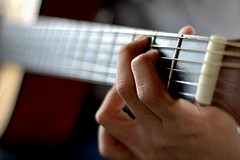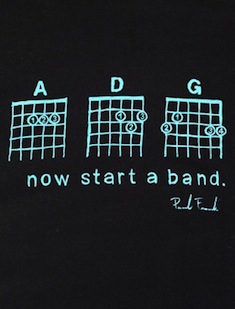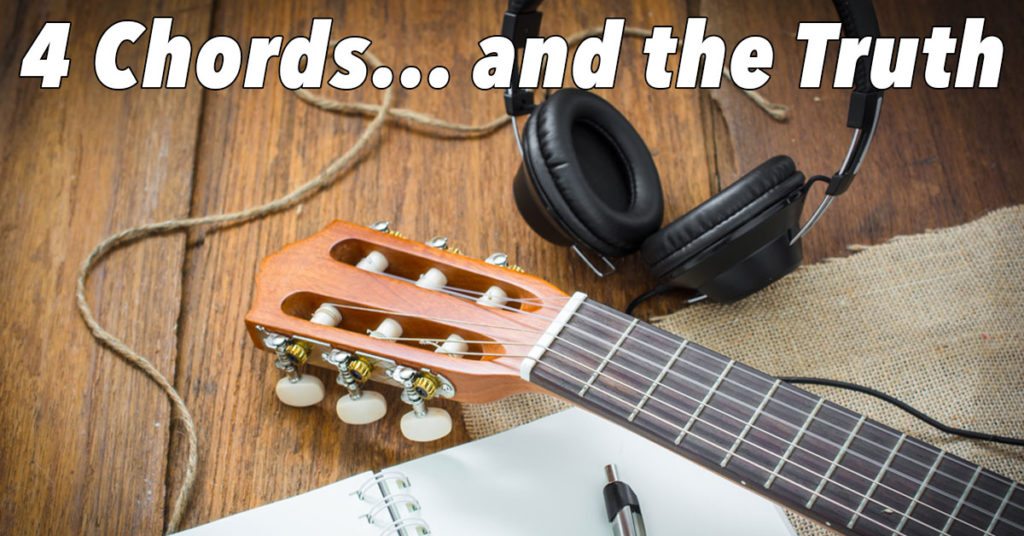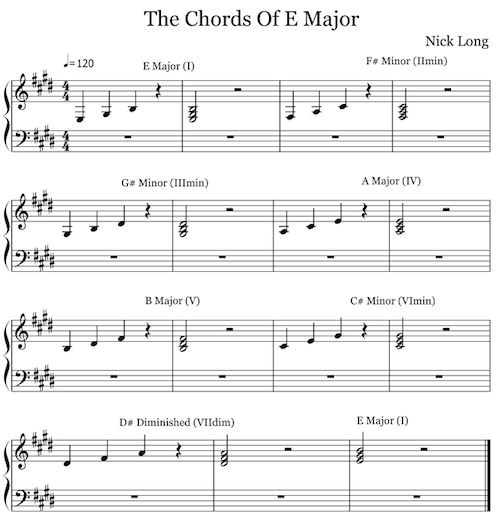There’s an old joke that asks:
“What’s the difference between a rock guitarist and a jazz guitarist?”
Answer:
and a jazz guitarist plays a million chords to three people!”
That may be true, but if you want a stone cold hit you need to write a four chord song. Don’t believe me? Check out “The Four Chord Song” by Australian comedy rock band Axis of Awesome.
Well-trained ears may even pick out what the four chords are (guitarists: no peeking at Lee’s left hand!)
Warning: This video contains a few F bombs if you are offended by such things or you want to play it to youngsters please use the following link: ![]() Kid-friendly version
Kid-friendly version
It turns out that the four magical chords are E, B, C# minor and A. But with so many chords to choose from, why did dozens of hit songs end up with the same four chords?
At first glance, it seems strange that so many songs should have the same chords. After all, with 12 notes to choose from, and a choice of major or minor, there should be thousands of pleasant-sounding chord progressions and we should never need to repeat ourselves. Unfortunately for budding songwriters, the odds are that picking four chords at random will result in something that sounds horrible. So what are the secrets behind those four magical chords? To find an answer we need to understand where chords come from.
Where Do Chords Come From?
Most Western music is based on the notes of a particular scale, often called the key*. 
If a song is in C major, you can be confident that any of the notes on the C major scale will sound good and are unlikely to clash. Chords are no different; any chord that contains only notes from the song’s key will sound like it fits in with the song. Luckily, we do not have to find them by trial and error. There is a simple trick we can use to build all of the chords of a key. Pick a note from the scale to be the first note of your chord, then move two steps up the scale for your next note, then up two more for the final one.
If we take the Axis of Awesome as an example, the song is in the key of E major so we have the notes: E, F♯, G♯, A, B, C♯, and D♯.
Right then, let’s make some chords! We’ll use the trick from above to pick out the right notes:
| Notes | Chord Name | Chord Number |
| E G♯ B | E Major | I |
| F♯ A C♯ | F♯ Minor | II |
| G♯ B D♯ | G♯ Minor | III |
| A C♯ E | A Major | IV |
| B D♯ F♯ | B Major | V |
| C♯ E G♯ | C♯ Minor | VI |
| D♯ F♯ A | D♯ Diminished | VII |
Looking at the table, you can see that from our E major scale we have the four magical chords E, B, C# minor and A!
* This section contains a few simplifications for the sake of brevity. If you want to learn more about chord theory there are lots of great books available and keep your eyes peeled for future articles here on EasyEarTraining.com.
What Have The Romans Ever Done For Us?
We have found out why songs in the same key tend to have the same chords, but there is another secret behind the Axis of Awesome’s “Four Chord Song.” Many of the songs they weave into their medley are not in the songs’ original keys (for example, U2’s version of “With or Without You” is in D, “Let It Be” is in G, and “Can You Feel the Love Tonight” is in B♭). In other words, Axis of Awesome transposed all of the songs into E major regardless of their original key. Does this mean they are cheats and the four chords are not magical after all?
Far from it. If you go through every major scale and figure out all the chords, a pattern emerges. Whatever major scale you start with, you will find a major chord, then two minors, then two majors, then another minor, and finally a diminished chord.
If you look again at the table above, you will notice that I labeled our list of E major chords with Roman numerals. If we call the chords in “Four Chord Song” by their numbers rather than their names, our chord progression of E, B, C# minor, and A becomes I-V-VI-IV. In fact, regardless of what key they are in, all of our four-chord songs share the progression I-V-VI-IV.
This unassuming sequence of Roman numerals is the source of our four-chord magic.
Now let us step back to the 1950s, because before there was the four-chord song there was the Three-Chord Trick.
Anyone Can Play Guitar
 If you were to write down the chord sequences of every rock and roll, country, or blues song released during the 1950s or early ’60s using our Roman numeral approach, you might be surprised to discover that nearly every single one of them was based almost exclusively on the three major chords in our list: namely, I, IV and V. This shortcut to writing a pop hit became so famous that it was known as the Three-Chord Trick. The songwriter Harlan Howard claimed all you needed to write country music was “three chords and the truth” (which I have cheekily paraphrased for the title of this article).
If you were to write down the chord sequences of every rock and roll, country, or blues song released during the 1950s or early ’60s using our Roman numeral approach, you might be surprised to discover that nearly every single one of them was based almost exclusively on the three major chords in our list: namely, I, IV and V. This shortcut to writing a pop hit became so famous that it was known as the Three-Chord Trick. The songwriter Harlan Howard claimed all you needed to write country music was “three chords and the truth” (which I have cheekily paraphrased for the title of this article).
When a snobbish music critic dismisses a new band’s sound as, “derivative, three-chord rubbish,” or when Status Quo or the Ramones are described as always using the same three chords, these are the chords referred to. They may use E, A and B or C, F and G, but when we look at it as Roman numerals, it always comes down to I-IV-V.
Chord progressions heavy in major chords have a strident sound, perfect for energetic music like rock and roll, and changing between major chords produces the joyous harmony associated with praise music (the change from IV to I is even called the “Amen” change for this reason). But when you require more emotional weight, using only those three energetic chords may leave your song sounding somewhat unsophisticated.
How Strange The Change From Major To Minor
Into each life, some rain must fall, and so sometimes songwriters need to convey a sense of sadness or yearning, and for this we need minor chords.
A common mistake budding songwriters make is trying to write sad songs using only minor chords. I am sure that even the greatest songwriters have embarrassing tunes like that squirreled away somewhere, the results of their inexperience and sparked by teenage angst (at least I hope it is not just me). In fact, it is almost impossible to find a popular song containing only minor chords, because they tend to sound self-pitying or oppressive, rather than moving.
Skilled songwriters, on the other hand, may use that ploy to play with our emotions. In “Street Spirit (Fade Out) by Radiohead, the verses consist of only A minor and E minor chords that establish a claustrophobic sound. When it finally moves to C major in the chorus, it opens up and suddenly you can breathe again. Listen to this clip and see if you can hear the change.
Could you hear it? If you need a little help: it’s on the line “Fade out again.”
The songs that make up Axis of Awesome’s medley are filled with lyrics such as “Don’t stop believing,” “I can’t live with or without you,” and “When I find myself in times of trouble, mother Mary comes to me.” If I were looking for a common theme among the songs, I would say they tend to sound positive in character, but also reflective, or as though one were striving to overcome adversity. If we set out to write a song with that kind of feel we would probably write a progression with mostly major chords, and slip in the occasional minor. You should not be surprised to hear this is exactly what we get with the I-V-VI-IV. Next time you are listening to the radio, see how many songs you can hear that use the I-V-VI-IV.
The Sensitive Female Chord Progression
You may wonder why “Four Chord Song” uses the VI chord rather than the other available minors in our list (II or III). The answer is that the VI chord is the strongest and most pleasing to the ear of the minor chords. It is the relative minor, so called because a minor scale starting on the same note as the VI chord would contain exactly the same notes as the major scale starting at I. For example, the E major scale we have been using has the notes E, F♯, G♯, A, B, C♯, and D♯. If we write the scale out starting from our VI chord C♯, we get the notes C♯, D♯, E, F♯, G♯, A, and B, which is the C♯ minor scale.
We could go even further, and start our whole progression from the VI chord. This would give us the progression VI-IV-I-V. You probably won’t be surprised to hear that this is also a very popular chord progression, so popular in fact that it is known as “The Sensitive Female Chord Progression.” It even has its own website.
They May Be Magical, But They’re Not Everything
By now, you might be feeling a little down, thinking that perhaps all the genius songwriters you idolized are just hacks churning out the same chord sequence again and again (this is not true – check out the chord diversity of these easy-to-play famous tunes!).
 You may even be thinking about writing a sensitive song about it, using the VI-IV-I-V progression – until you realize how ironic that would be.
You may even be thinking about writing a sensitive song about it, using the VI-IV-I-V progression – until you realize how ironic that would be.
But fear not. The choice of chords is just one aspect of writing a song, and an overemphasized aspect at that. The chord progression provides the harmony of a song, but music contains many elements. As well as harmony, there is melody, rhythm, tempo, meter, dynamics, articulation, and timbre. And beyond the music, many artists feel that the story told by the lyrics is just as important to the success of a song.
Ultimately, it is the emotional impact a song has on you that matters, not just its chords. If I told you that “Born In The USA” uses the same two chords all the way through (B and E), or that “Chain of Fools” by Aretha Franklin only has one chord (Cm), would it make you think less of these wonderfully impassioned works?
Next time you have the radio on, see how many songs you can hear that use the I-V-VI-IV progression. Want more information on playing chord progressions by ear? Just follow the link below!











Hey there.. This is a brilliant article. So glad to have come across it! I really enjoyed the read!
Fantastic article. Well-written & informative. Exactly what I was looking for. Thank you.
A good, usefull articale. Does this formula work for all scales and modes.
Hi Steve
Yes, you can harmonise any mode in the same way to derive the associated chords.
All the common modes can be derived from the major scale in the same way. For example the Dorian mode is the same as the C major scale played D to D.
Found what I was looking for. Thanks
I'm a beginner at guitar (had 5 lessons so far) and having discovered the Axis of Awesome's Four-Chord Songs just last week, I found this article to be a perfect explanation of why it works.
And having tried a few 4-chord songs myself, it's been a huge boost to my confidence. I never thought that after just 4 lessons, I would be able to play an entire song from beginning to end.
Great! Glad to hear it helped you :)
It is a wonderful demonstration of how easy it can be to reach a satisfying point with guitar. So many students bash their heads for far too long thinking they need to learn new chords for every new song… when in fact they can go a very long way with just 4!
You might like some of our other articles on chord progressions: https://www.musical-u.com/topic/relative-pitch/chord-progressions/
I have just added 1-V-V1-1V to my music practice app http://itunes.apple.com/gb/app/jazz-practice/id47…
Nice article and website. But shouldn't the chord be written vi rather than VI since it's minor?
Hi Jeff,
Glad you enjoyed the article!
The answer is: it depends!
In the classical world, you're absolutely right. Upper case Roman numerals are used for major chords, and lower case for minor chords.
On the other hand, rock and jazz notation often uses upper case numerals exclusively, and either:
– relies on the reader to interpret based on common chord usage
(e.g. it would be unusual to use A major in the context of C major, F major, and G major – A minor is far more likely)
or
– adds symbols like a minus sign or 'm' to indicate that it's a minor chord.
In this article I believe Nick chosen the all-uppercase numerals for simplicity, since the particular chords to use were being explained in detail anyway.
Hi from London – I read your book some time ago and I have used the 4 chord trick loads in my piano lessons since then so thank you so much! Keep up the good work! ;-)
Indeed, very useful article. I had the same doubt re VI and vi. Before discovering this progression the I – IV – V one was the skeleton for me, and I used vi in other progression sets. But then they got together beautifully.